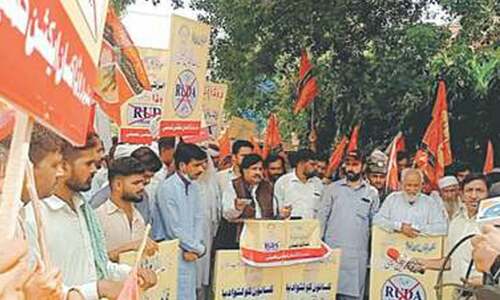As time is running out for plantation and growth of Rabi crops, particularly the all-import wheat, growers are planning to re-converge, this time in Lahore. The purpose is to wake the authorities from their deep slumber and resolve the problems the farming community is facing in securing fertiliser, affordable electricity, and diesel for the irrigation tube wells.
Kissan Ittehad, a group of farmers representing smallholders, had earlier held a 10-day protest in Islamabad in the last week of September forcing the federal government to announce a ‘Kissan package’ worth Rs1.8 trillion. But this announcement is so far confined to papers as no concrete practical steps have been taken by the authorities for implementing the package.
This time the farmers are organising a tractor march in Lahore on Tuesday (tomorrow) to put pressure on the Parvez Elahi government, over-engaged in political wrangling involving the dissolution of the Punjab Assembly and subsequent ouster of the incumbent provincial setup, for accepting their demands.
Urea fertiliser has been sold in the black market for the last two years as the Punjab government is turning a blind eye to the issue. Crop yields are declining because of poor application of the compost and long queues of growers outside dealer shops to grab a couple of bags. Against the official rate of Rs2,250 per 50kg urea bag, it is available at a price of up to Rs3,200 these days.
The farmers are organising a tractor march in Lahore to put pressure on the government to accept a list of demands
Ittehad president Mian Umair Masood laments that the government has not yet begun releasing subsidy on DAP (di-ammonium phosphate) fertiliser, nor has it fixed wheat support price at par with the Sindh government, which has announced the price at Rs4,000 per 40kg. He says they are also seeking an enactment by the provincial assembly to protect farmers’ rights like the Seed Act 2016 that safeguards the rights of plant breeders.
But the question is: will this mobilisation succeed in achieving its objectives? Many farmers are pessimistic about the outcome of the protest. They believe that, like the federal government, the Punjab rulers will only buy time by hoodwinking the protestors through the announcement of some appealing measures never to be materialised.
“How can a government take any concrete steps when its own future is uncertain? The rulers will make promises only to gain time as the destiny of these commitments will not be different than what we have seen of the promise of supplying electricity to farm tube-wells at Rs13 per unit and announcing a ‘subsidised’ fertiliser price more than what is prevailing in the open market,” says Ebadur Rehman.
A representative of the Farmers Associate Pakistan (FAP), which speaks for big landholders, says the farmer leaders are now compelled to come out on roads in a ‘futile’ exercise as their supporters are seeking results from them about the investment in terms of time and money they had made during the previous protest.
Farmers have been protesting against each successive government for one reason or the other. Mr Rehman asserts that the situation will remain the same until and unless there is a proper agriculture policy in place like the one for the industrial sector in which there is a clear outline for the future.
In the farming sector, temporary measures are designed by non-technical bureaucrats, who assume office for a short period and a transferred to some other sector by the time they can understand the agriculture department dynamics, he says.
To ensure growth in the agriculture sector and keep farmers engaged and focused on their lands, he proposes the government chalk out a long-term strategy to guarantee crop feasibility. A strategy that includes subsidies on seed, compost and pesticides, the introduction of high-yielding seeds resilient to climate change, affordable irrigation and an exploitation-free market, he adds.
“Neighbouring India spends around $100 billion on farm subsidies, and we, being one-eighth in agricultural economy size to that of India’s, should pay out at least $12bn to be competitive in the region. But, alas, farm subsidies in Pakistan are hardly $1bn.”
Farooq Tariq, a leader of the Pakistan Kissan Rabita Committee, laments that most of this subsidy goes either to the coffers of the agro-industry or the big landholders, leaving the small farmers high and dry. “The government is playing in the hands of fertiliser manufacturing companies and offering them subsidies. The government should support the low strata of society instead of the resourceful upper classes.”
The government needs to take a series of governance reforms and technology interventions to uplift the financial and social status of the agriculture-dependent populations. There are over a dozen key areas — from legal framework to improving purchasing power of the smallholders enabling them to get farm inputs without being exploited by the market forces — where government attention is required.
“The farming community needs legal protection as the Seed Act 2016 has robbed it of its right to retain a part of its produce as seed for the next season. This is strengthening monopolies of the seed companies. The farmers’ poverty should be taken care of first because a lack of resources makes them vulnerable to exploitation by powerful individuals and institutions,” says Mr Tariq.
He is happy to see that inspired by the Indian farmers’ 13-month movement, a big tractor march will be organised in Pakistan. Quoting the Indian movement’s leaders, whom he recently met at an agricultural moot in Nepal, he says that Pakistani farmers also need a long-term organised movement to get tangible results.
Published in Dawn, The Business and Finance Weekly, December 19th, 2022
















































